POTD was relatively simple layout and lathe work, but so far has been one of my most satisfying projects. As usual with my posts, some backstory drivel. . .
My mom was diagnosed with lymphoma in December 2020. She last ate a full meal on Christmas Day, 2020 and got sick from that. She has multiple things going on, including a growth around her duodenum. More boring biology; the duodenum is the start of your small intestine leaving the stomach. She has a stricture about 8” down the duodenum that has her plumbing totally plugged off. She had something called a G-J tube (gastrostomy-jejunostomy tube) installed through her abdomen which vented her stomach and allowed tube feeding into her small intestine.
The G-J is two tubes in one; one tube went through her side into her stomach where it splits into two tubes. One ended in her stomach (G-tube), the other snaked through the restriction in her duodenum (J-tube) and ended in her jejunum (small intestine downstream from the duodenum). The G-tube portion allows her stomach to drain as her body is still secreting digestive juices into her stomach. With the duodenum plugged tightly, the only place for those juices to go is back out her mouth. The J-tube is used for nutrition through a pump system (15 hours a day tied to an IV pole).
She had problems with the G-J tube because of the stricture around the duodenum. My analogy is like putting your thumb over the end of a garden hose which builds pressure and acts like a jet. The stricture in her duodenum pinched the J-tube enough that when it was flushed (water) by the pump system, it jetted the tubing back up into her stomach.
Last September her doctor was unable to snake the 10th (?!?) G-J tube through her duodenum. A surgeon was able to open her up and install a dedicated J-tube into her jejunum. She now has two tubes: G-tube to drain her stomach contents and a J-tube for tube feeding, hydration and meds.
My sister and I trade her back and forth every month. During the day, we take the contents of the drained G-tube (gastric juices) and syringe them into the J-tube as her body needs those enzymes for digestion, hydration and electrolytes. We’d also run 50 ml of water every hour as she effectively can’t drink by mouth. The work isn’t difficult, but it ties us to her throughout the day; we need to do something every hour. She has a 5’ length of tubing running to a bag to capture the drained contents of her stomach 24/7.
Long story longer, our mom is having a PET scan to see if she is able to have a bypass surgery called a gastrojejunostomy. This procedure ties the jejunum directly to the stomach bypassing the problem in her duodenum. If she is able to have the surgery, it would allow her to eat solid food again and gain one heck of an increase in quality of life. No more syringing in hydration, meds and gastric juices ever hour of the day when she’s not hooked to an IV pole. And no more carrying around a drain bag of her stomach contents 24/7. No more tied to an IV pole for 15 hours a day. On the downside, it doesn't help with the cancers she's fighting, but it would give her a more normal existence for the rest of her days.
Surgery we're hoping our mom is able to get. Ties her small intestine to her stomach directly to bypass the restriction in her duodenum (between the stomach and the connection between the small intestine and stomach)
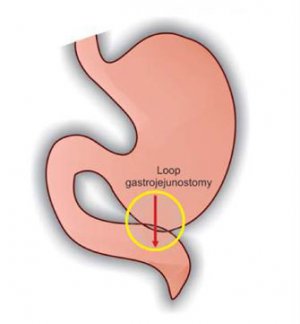
I asked the surgeon if it would be possible to tie the G-tube draining her stomach directly to the J-tube in her jejunum. We are basically doing that already as we take the collected contents of her stomach and manually syringe it into her small intestines. He said, “Sure, tying the G and J tubes together is basically an external gastrojejunostomy”. Surgery checked with the manufacturer of the G and J tubes and such a fitting does not exist. So, guess what my project of the day was!
My task was to duplicate the feeding tube/ drain tube end fittings and connect them with a length of tubing. The feed tube end fitting is made from polyethylene, I have a decent supply on hand for the fittings.
Measured the diameters/taper and chucked up the PE. Standard fare from there: Face, center drill, turn the tapers, drill a through hole, part, flip and drill the back side for the tubing (tubing was from a gravity feed tube with a larger diameter than the normal feeding tube).
Lathe work for both the G-tube and J-tube fittings. G-tube first; face, center drill, drill a through-hole, cut the taper for jamming into the silicon G-tube female fitting, relieve the connecting tube end and part. I did the G-tube fitting with a lot of material sticking out of the chuck.
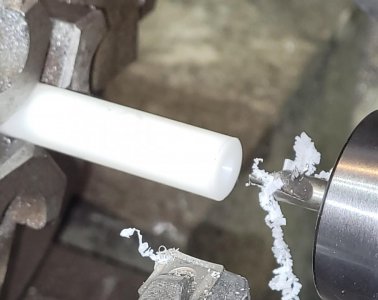
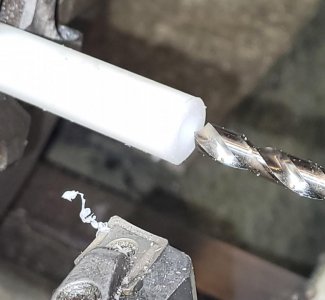
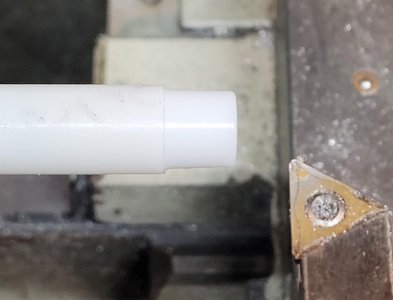
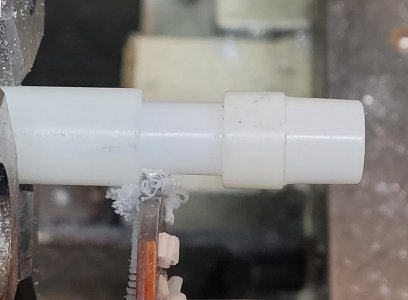
J-tube end fitting. Pretty much the same as the G-tube but this end has two steps. I also switched things up and turned the tapers between centers, then drilled the through hole.
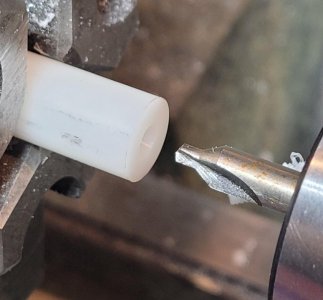
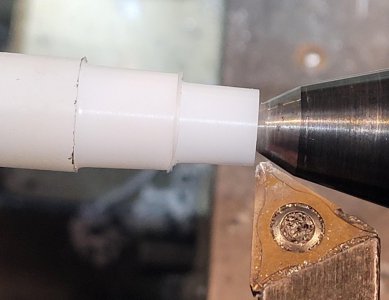
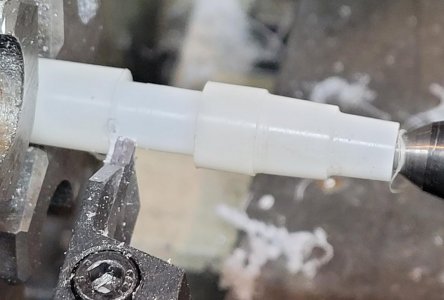
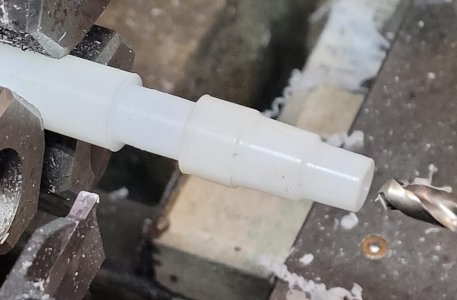
Flipped both end fittings and drilled a hole in the back side to accept a connecting hose.
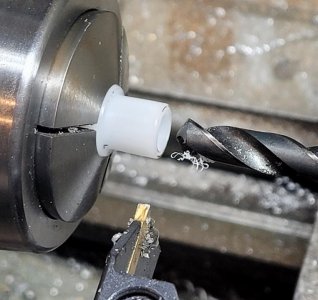
The tubing was heated in boiling water and press-fit into the ends. I ran a drop of superglue on the outside edge of the joint for belt and suspenders. They use superglue in place of stitches in a pinch, won’t be an issue here either.
Two end fittings and a length of PVC (?) tubing from a gravity feed IV bag
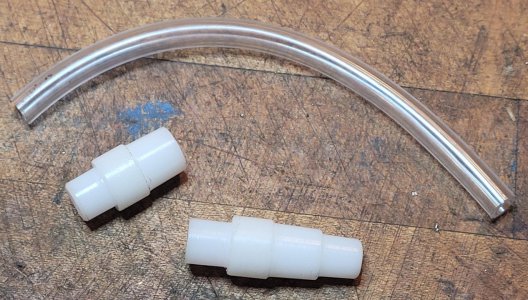
Standard feed tube up top, my male to male connection hose below. I've got the J-tube ends next to each other. Note that I didn't bother with the last two smaller steps as her J-tube appliance accepts the smaller of the two steps in my tube. This also let me use a larger diameter connecting tube as I didn't want to cause a restriction in the flow from her stomach to her jejunum.
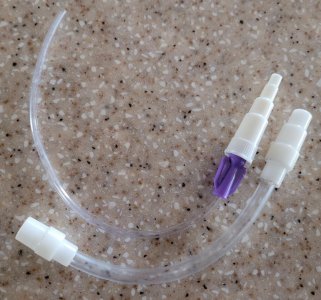
Our mom was a little apprehensive about being a “science project”, but so far so good (5 days in)! It’s helped with her (and her caregivers’) quality of life as she can hydrate herself throughout the day. No more syringing in gastric juices every hour. She can also freely walk without having a 5’ length of tubing running to a drain bag. Her PET scan is scheduled for Friday, May 6; your thoughts and prayers would be appreciated!
Our mom hooked up with the connection hose. The upper tube is a drain from her stomach, lower tube runs into her jejunum. My hose is the one in between. I secured the fitting with foam tape on top of the PE ends that jam into the silicon tube ends.
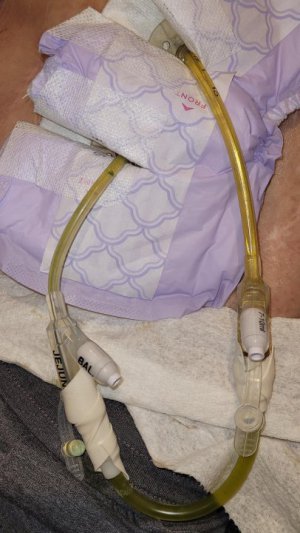
Thanks for looking, Bruce
p.s. Probably need to throw some legalize in at this point. I am not a doctor and do not endorse or suggest anyone else try my male to male connector. I consulted with her surgeons before doing any of this work. Everything was thoroughly sterilized before use and reviewed with her surgeon before we hooked her up. And in case you were wondering, a sample of the connection tube has been sent to the manufacturer for possible inclusion in their catalog.















